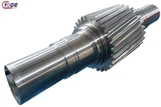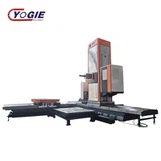Industrial double helical gear shaft and herringbone gear shaft
Products Description

A double helical gear shaft, also known as a herringbone gear, is a type of gear that has two helical gear sets with opposite hands that are cut into the same gear. The helical teeth are cut at an angle to the axis of the shaft and are arranged in a V-shape. This design reduces the noise and vibration associated with conventional spur gears.
Products show

materials selections of double helical (herringbone) gear shaft
The materials of gear shaft usually include carbon steel, alloy steel and other materials.
Material selection principles for gear shaft
As a relatively important component in the transmission mechanism, the gear shaft must consider the following principles when selecting materials:
1. Select materials according to the stress conditions. Gear shafts usually work under high speed and high load conditions, so their materials must have sufficient strength and toughness to withstand impact and fatigue loads.
2. Select materials according to the use environment. The use environment of gear shafts is usually affected by factors such as temperature and humidity. Therefore, when selecting materials, its corrosion resistance, heat resistance and other properties must be considered.
3. Select materials according to processing performance. Gear shaft processing usually adopts turning, grinding and other processes, so when selecting materials, its processing performance, such as cutting performance, heat affected zone and other factors must be considered.
Common gear shaft materials
1. Carbon steel: Carbon steel is a commonly used gear shaft material with good strength and hardness, suitable for some light-load transmission mechanisms with lower requirements. Common carbon steel materials include C35, C45, C55, etc.
2. Alloy steel: Alloy steel is a gear shaft material with better performance. It has a certain amount of alloy elements added, such as Cr, Ni, Mo, etc. It has high strength, hardness and toughness, and is suitable for some high-load, high-speed, and high-precision transmission mechanisms. Common alloy steel materials include 40Cr, 20CrMnTi, etc.
3. Stainless steel: Stainless steel is an excellent anti-corrosion material with high corrosion resistance and high temperature resistance, and is suitable for some harsh use environments. Common stainless steel materials include 1Cr18Ni9Ti, 2Cr13, etc.
4. Other materials: In addition to the common gear shaft materials introduced above, there are some other materials, such as aluminum alloy, copper alloy, etc. However, the scope of use of these materials is relatively limited, and they are usually only suitable for some light-load transmission mechanisms with low requirements.
Common heat treament methods

Quenching treatment
Quenching is one of the common methods for heat treatment of gear shafts. By heating the gear shaft to a certain temperature and then cooling it rapidly, a Mohsite structure is produced on its surface, thereby improving its surface hardness and strength. It should be noted that parameters such as heating temperature, holding time and cooling rate need to be controlled during quenching to avoid problems such as thermal cracks and deformation.
Tempering treatment
Tempering is an important part of heat treatment of gear shafts after quenching. Tempering can reduce the brittleness of the gear shaft and improve its toughness and plasticity. The tempering temperature, time and cooling method have a great influence on the performance of the gear shaft and need to be precisely controlled.
Carburizing treatment
Carburizing is a surface heat treatment method that can form a carburized layer with a high carbon content on the surface of the gear shaft. This layer has high hardness and wear resistance, and can improve the strength and load-bearing capacity of the gear shaft. Carburizing temperature and time, the selection of carbon source and carburizing agent, and the depth of the carburized layer are all important factors affecting the carburizing quality.
Test of Products
Rolling method to detect helical gears
The rolling method is a relatively simple and effective method for detecting helical gears. The specific steps are as follows:
1. Insert the two helical gears to be detected together
2. Manually roll the gears
3. Observe the rolling state and deformation of the gears at the joints
4. Judge the quality of the gears based on the observation results
The advantage of this method is that it is simple and easy to operate, and does not require special testing equipment, but its disadvantage is that the results are greatly affected by human subjective factors, and sometimes it takes multiple tests to get an accurate conclusion.
Measurement method to detect helical gears
The measurement method is a commonly used method in helical gear detection, and its specific steps are as follows:
1. Use special testing equipment such as gear measuring instruments and bed-type measuring instruments to perform geometric measurements on gears;
2. Make conclusions based on the measurement results.
The advantage of this method is that the results are relatively accurate and less affected by human factors, but its disadvantage is that it requires special instruments and equipment and is more expensive.
Gear micrometer measurement method to detect helical gears
The micrometer can accurately measure the distance between the top and root of the gear teeth, thereby calculating the slope and tooth height of the gear. The specific steps are as follows:
1. Measure the pitch at the root of the gear teeth;
2. Substitute the pitch value into the formula to calculate the tooth height and module;
3. Judge the quality of the gear based on the calculation results.
The advantage of this method is that it can accurately calculate the various parameters of the helical gear, but its disadvantage is that it requires special measuring tools such as micrometers, and requires higher technical requirements for the inspectors.
Contact us
Do you have any specific questions about the design and manufacture of the shaft or gear shaft ? Contact Yogie!Our sales engineers will work with you from start to finish to ensure that your project is completed to your requirements.
Hot Tags: industrial double helical gear shaft and herringbone gear shaft, manufacturers, supplier, factory, customized, cheap, price, in stock, for sale

















